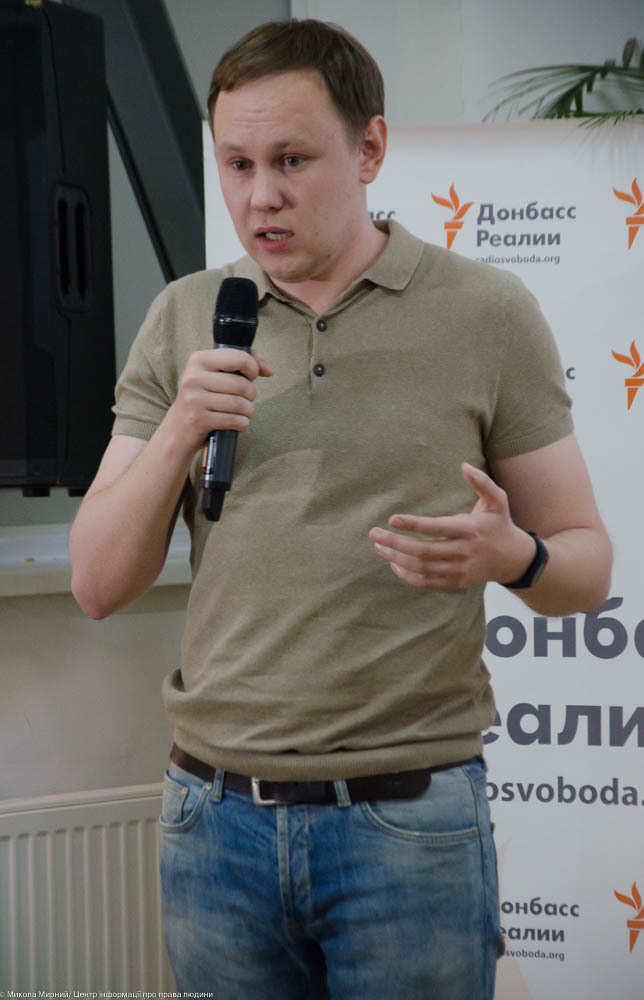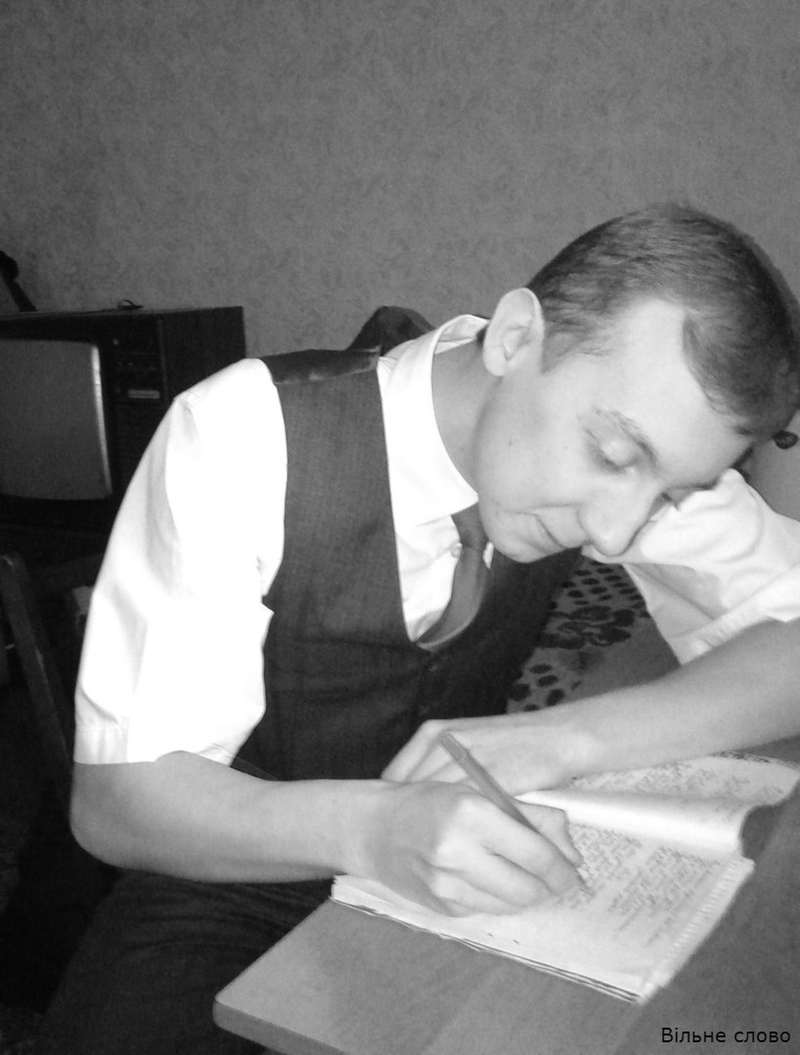
This week, a book by journalist Stanislav Aseev will be presented in the Kyiv art centre Izolyatsiya that moved here from occupied Donetsk. Stanislav Aseev is imprisoned by “DPR” militiamen since more than a year. The book contains essays and blogs by Stanislav that he has sent, for a period of two years, from occupied Donetsk to “Ukrains’ki Tizhden” (the Ukrainian Week) “Dzerkalo Tizhnya” (the Weekly Mirror) and “Radio Liberty”.

This dialogue was retold by the former Member of Parliament Egor Firsov, who studied together with Stanislav Aseev on the philosophical faculty of the Donetsk University of Informatics and Artificial Intelligence.
With this very dialogue, at the beginning of June 2017, began the search for information about the whereabouts of the journalist. Friends and family, as well as the editors of the newspapers for which Stanislav wrote, faced a tough choice: should they reveal who hides behind the pseudonym “Stanislav Vasin”?
Stansilav’s friend Denis Kaplunov said that Stas doesn’t answer the phone. His friends started to use his Facebook page to ask where he was.
“He answered to some of these inquiries that he got sick, that he couldn’t speak, that he was in hospital. To our questions, why he answered his Facebook but didn’t call his already desperate mother, he didn’t give an answer,” says Kaplunov.
Stanislav’s worried family, friends, and colleagues agreed on a public announcement of his disappearance. They knew that Stanislav met and corresponded with pro-Ukrainian people, who lived in the occupied part of Donbas. They feared that Stanislav’s Facebook site could be used by the separatist militiamen to trick pro-Ukrainian citizens into talking to them. Staying silent could have endangered them.
In the cell next to where Stas was held, a now freed detainee was imprisoned, Viktor, who prefers not to give his family name. He was freed during the prisoner’s exchange in December 2017. Viktor says that Stansilav Aseev was imprisoned not on June 2, but already on May 10, from which time his work was controlled by his jailors. The editor of the “Donbas Realiiy” Program at Radio Liberty Andrey Dekhtyarenko read out Viktor’s testimony during the presentation of the book.
“We were in neighbouring cells since May 10, 2017, the day they took him in. I couldn’t see his face, only his legs and his back when they led him to the toilette or the shower. Sometimes when they didn’t close the cell door but only the grate, we could talk to each other. He said that he was a journalist. He was worried all the time that no one would find out where he was. I and other prisoners were imprisoned there under our real names, he was there under an invented name.
He was arrested on May 10, 2017 on Lenin square. Sometimes they took him back to the apartment he rented and had him write under their control, up to the moment when they decided they would stage a burglary in his apartment. For his report about Yasinovata they took him there already in handcuffs.
He was tortured with electroshocks to the ears. Stas used to say that if you received such an electroshock your eyes would pop out of your head. They did this with 30 scale units and threatened to put it up to a hundred. Probably, what they meant was volts. They beat him up so badly that the entire lower part of his body was simply black.
But at times they allowed him to write. They gave him paper and pen. He wrote like a diary. When they allowed us to speak, he read to me what he had written. He wrote about himself being in this cell.
The first three days Stas could not eat. He shared the food he was given with others. He gave away his bread. Later, I suggested he’d dry the leftover bread. We were given food three times a day. It came in disposable bowls and it was extremely little. Stas refused to eat curdled milk. I told him that was stupid. Better eat this kind of food than to die of hunger here.
His jailors took away his bank card from Privat Bank and removed 10.000 UAH from it (approx. 300 Euro). They said it was for his imprisonment, for the fuel and the car that brought him to Yasinovata. Twice they bought him a burger. He was given half a kilo of sugar and a set of painkillers.
On the 2nd of June the, “DPR Ministry of State Security” already officially declared him their prisoner, when they decided not to let him meet his mother after all, although they had promised her on the telephone to arrange a meeting with her son. On the phone his mother asked that Stas would come to her. He looked at his jailors and they nodded like crazy. Then they backpedalled. One of his jailors said that he travelled to Moscow especially for him to include him in the list for the prisoner’s exchange.”
Stanislav Aseev was a student of the religion scholar Igor Kozlovskiy who was liberated after two years in detention. Kozlovskiy said that Stanislav was held in the premises of the former art-centre “Izolyatsiya” in Donetsk, where the militias have established a prison. Igor Kozlovskiy remembers that the militiamen were searching for Stas one and a half year.
“After half a year of my imprisonment, people from the “DPR Ministry of State Security” came to me and asked who from among my students stayed behind in Donetsk. I told them that they had all left. They asked me who Stas Vasin was. I told them that I didn’t know, but that I thought it was a group of authors. But they had seen that this Vasin, after he learned that I had been arrested, called on all former Students of Kozlovskiy they should leave for the territory controlled by the Ukrainian government.” The professor remembers.
He thinks that the fighters were able to seek out Stanislav because in his writing, when describing life in occupied Donbas, he gradually gave up more and more details about himself. Representatives of the “DPR Ministry for State Security” told Igor Kozlovskiy that they have an audio recording of his voice, that they know how he dresses and that he lives near the “Kalmius” military unit.

The 27-year old Stanislav Aseev loves jazz and running. He has a bachelor’s degree with distinction in philosophy and a master’s degree in religious studies. He worked in some 15 different professions, was a carrier, dug out graves, worked as a vendor and in a bank.
In his essays, Stanislav described life under occupation: what people think about the occupation, how city life changed, he wrote about the roots of the conflict, what happens in the conflict zone and so on. I reached the conclusion that speaking to the militiamen he was trying to understand what drives them, where their hatred came from.
Andrey Dekhtyarenko, the editor of Donbas Realiiy, addressed the militiamen and promised that “journalists will not forget about those detained.”
“We will bring this issue to the attention of the international community” he promised. He also called on journalist to write about Stanislav Aseev, to read his book and to discuss it in their writing and on social media.
The ambassador of the United States in Ukraine, Marie Yovanovitch, said she would make use of all means to free Stanislav Aseev.
Despite all its efforts, the Ukrainian government did not succeed in freeing to Stanislav last December together with other detainees. His name did not occur in the list for reasons unknown. This was announced by Iryna Herashchenko, a member of parliament for BPP and a member of the humanitarian subgroup of the tripartite contact group of the Minsk negotiation.
Herashchenko called on all of Ukraine’s international partners to demand from the illegal armed groups that they grant their political prisoners the right to send and receive mail as well as to make phone calls. Herashchenko says that the ICCR in four years of warfare has not visited once the illegal places of detention in the occupied territories of Eastern Ukraine.
She announced that Ukraine is ready to hand over to Russia 23 sentenced Russians who committed “subversive acts, terrorist attacks, or have publically called into question the territorial integrity of Ukraine” in order to free DPR’s prisoners, including Stanislav Aseev. In her words, the militias of Eastern Ukraine confirm that they hold 20 citizens of Ukraine as prisoners. This means that there must be dozens of disappeared people.
A copy of “In Isolation” one can get for free in the Izolyatsiya art centre after making an order via private message on the site of Donbas Realiiy.
In the meantime, Stanislav’s friend, Egor Firsov, dreams of the day when he can call Stanislav’s mum in high spirits:
-Hello, this is Egor Firsov. You probably already know that the exchange has taken place.
-Yes of course. Is everything alright?
-Yes, everything is alright, Stas is free, ill hand him the phone.

On October 2 at 16:00 in Poltava Art Museum human rights defenders presented the publication "City, where the war had started" about...

On October 2 at 16:00 in Poltava Art Museum human rights defenders will present the publication "City, where the war had started" ab...

Interactive exhibition of testimonies "On the Rift" about the violation of rights of civilians during the war in Donbas was presente...
The Secretariat of the Coalition «Justice for Peace in Donbas»